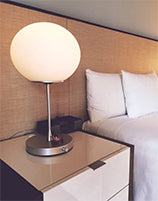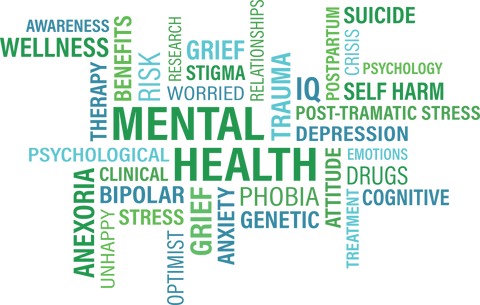Circadian Lighting and Health

There is no denying the impact lighting has on humans. In fact, our daily exposure to light, especially the time of day we are exposed to certain wavelengths, plays a monumental role in a good night’s sleep. As any doctor will tell you, not getting enough sleep can quickly lead to health issues, as well as an overall loss of cognitive function. When people become cranky from lack of sleep, it is because the effects of sleep deprivation are an unpleasant experience for the human body in a myriad of ways. With the growing understanding of how light affects us, more and more solutions are being put in place to encourage a healthy sleeping cycle. Let’s take a closer look at the relationship between circadian lighting and health.
What is the circadian rhythm?
The circadian rhythm is a basically an internal clock that tells the body when to sleep and when to wake. This rhythm is affected by light because certain levels and types of lighting simulate daytime which is when the rhythm keeps you alert whereas other light tones indicate to the body it is time for rest. This internal rhythm is essential to the sleep cycle occurring in a natural, healthy manner.
What are the health consequences of sleep deprivation and/or poor sleep quality?
When the circadian rhythm is thrown off balance, sleep deprivation can set in. Not getting the recommended 7-8 hours of sleep every night can lead to a host of issues. In fact, according to Science Daily, “A new study has found that chronic disruption of one of the most basic circadian (daily) rhythms -- the day/night cycle -- leads to weight gain, impulsivity, slower thinking, and other physiological and behavioral changes in mice, similar to those observed in people who experience shift work or jet lag.” There is no denying the role sleep plays in the functions of the human brain. Studies have also indicated that poor sleep quality can lead to these same issues. Lack of sleep and poor quality of sleep also result in higher levels of stress hormones being present in the body, as well as an overall feeling of unhappiness or discontent.
What is circadian lighting?
While you may know that sleep is imperative for good mental function, the matter of how light plays into the scenario is still worth answering. When the eyes receive certain wavelength and color temperatures, it sends signals to the brain regarding the circadian rhythm. With blue wavelengths of light, the awake and alertness levels of the brain are signaled which is fine during the day, but if humans are being exposed to these wavelengths prior to the time when they should be entering the resting phase, it can result in the disruption of the circadian rhythm. In essence, circadian lighting is lighting planned with this factor in mind. While you could simply plan the lighting to use only warmer tones of light or incandescent bulbs, this could be an issue depending on where the light is located. For instance, alertness signified by lighting is important for the function of the human brain throughout the day. In areas such as an office, you want these blue wavelengths, but many researchers and manufacturers are finding the absence of blue wavelengths is beneficial in the living room and bedroom to help signal to the brain time for rest. New technology is being introduced in LED lighting solutions to remove the blue wavelengths to allow for LED fans to still use their favorite type of lamp in these areas of the home. However, an incandescent bulb will also achieve the same effect.
Sources
https://www.sciencedaily.com/releases/2009/10/091026225744.htm

Suggested Lighting for Behavioral Therapy Facilities
With our suggested lighting for behavioral therapy facilities, find out how illumination plays a role in the mental state of patients.
Read Article High Bay LED Lighting
High Bay LED Lighting
 Industrial Low Bay Lighting
Industrial Low Bay Lighting
 Industrial Strip Lights
Industrial Strip Lights
 Vapor Tight Lighting
Vapor Tight Lighting
 LED Shop Lights
LED Shop Lights
 Hazardous Area / Explosion Proof Lighting
Hazardous Area / Explosion Proof Lighting
 Loading Dock Lights
Loading Dock Lights
 Construction / Portable Lighting
Construction / Portable Lighting
 Industrial Ceiling Fans
Industrial Ceiling Fans
 LED Work Lights
LED Work Lights
 Clearance
Clearance
 Troffer Lights
Troffer Lights
 LED Flat Panel Lights
LED Flat Panel Lights
 Drop Ceiling Lights
Drop Ceiling Lights
 Suspended LED Lights
Suspended LED Lights
 Exit / Emergency
Exit / Emergency
 Wrap Lighting Fixtures
Wrap Lighting Fixtures
 Gooseneck and Barn Lights
Gooseneck and Barn Lights
 Commercial Stairway Lighting
Commercial Stairway Lighting
 Hospital Bed Lights
Hospital Bed Lights
 Commercial Sign Lights
Commercial Sign Lights
 UV Disinfecting Lights & Air Purifier Fixtures
UV Disinfecting Lights & Air Purifier Fixtures
 Recessed Lighting
Recessed Lighting
 Wafer Lighting
Wafer Lighting
 RGB LED Lights
RGB LED Lights
 Grow Lights
Grow Lights
 Refrigeration Lighting
Refrigeration Lighting
 LED Flood Lights
LED Flood Lights
 Outdoor Wall Lights
Outdoor Wall Lights
 LED Area Lights
LED Area Lights
 Parking Lot Lights & Poles
Parking Lot Lights & Poles
 Outdoor Post Top Lights
Outdoor Post Top Lights
 LED Stadium Lighting
LED Stadium Lighting
 Canopy Lights
Canopy Lights
 Security Lights
Security Lights
 LED Bollard Lights
LED Bollard Lights
 Solar Powered LED Lighting
Solar Powered LED Lighting
 Dusk to Dawn Lights
Dusk to Dawn Lights
 Landscape Lighting
Landscape Lighting
 Outdoor String Lights
Outdoor String Lights
 Coastal Wildlife Lighting
Coastal Wildlife Lighting
 Outdoor House Lights
Outdoor House Lights
 Ceiling Fans
Ceiling Fans
 Ceiling Lights
Ceiling Lights
 Chandelier Lights
Chandelier Lights
 Pendant Lighting
Pendant Lighting
 Island Lights
Island Lights
 Track Lighting
Track Lighting
 Under Cabinet Lighting
Under Cabinet Lighting
 Vanity Lights
Vanity Lights
 Wall Sconces
Wall Sconces
 LED Tape Lights
LED Tape Lights
 LED Light Bulbs
LED Light Bulbs
 LED Tube Lights
LED Tube Lights
 LED Corn Lights
LED Corn Lights
 Vintage LED Bulbs
Vintage LED Bulbs
 Decorative LED Bulbs
Decorative LED Bulbs
 Fluorescent Light Bulbs
Fluorescent Light Bulbs
 Metal Halide Lamps
Metal Halide Lamps
 Shatterproof Light Bulbs
Shatterproof Light Bulbs
 LED Magnetic Strip Retrofit Kits
LED Magnetic Strip Retrofit Kits
 LED Strip Light Retrofit Kits
LED Strip Light Retrofit Kits
 High Bay LED Retrofit Kits
High Bay LED Retrofit Kits
 LED Troffer Retrofit Kits
LED Troffer Retrofit Kits
 LED Wall Pack Retrofit
LED Wall Pack Retrofit
 LED Street Light Retrofit Kits
LED Street Light Retrofit Kits
 Recessed Lighting LED Retrofit Kits
Recessed Lighting LED Retrofit Kits
 CFL Ballasts
CFL Ballasts
 Electronic Halide Ballast
Electronic Halide Ballast
 Emergency Ballasts & Inverters
Emergency Ballasts & Inverters
 Fluorescent Ballasts
Fluorescent Ballasts
 LED Drivers
LED Drivers
 High Pressure Sodium Ballasts
High Pressure Sodium Ballasts
 Metal Halide (HID) Ballasts
Metal Halide (HID) Ballasts
 Pulse Start Metal Halide Ballasts
Pulse Start Metal Halide Ballasts
 Electric Vehicle Chargers
Electric Vehicle Chargers
 Ballasts & Drivers
Ballasts & Drivers
 Electrical Supplies
Electrical Supplies
 Electrical Tools
Electrical Tools
 Switches & Receptacles
Switches & Receptacles
 Hand Dryers
Hand Dryers
 Electrical Power Cords
Electrical Power Cords
 Sensors and Timers
Sensors and Timers
 Smart Home Automation
Smart Home Automation
 High Bay Occupancy Sensors
High Bay Occupancy Sensors
 Outdoor Motion Sensor Lights
Outdoor Motion Sensor Lights
 Walkway Lights
Walkway Lights
 Office Lights
Office Lights
 Gym Lighting
Gym Lighting
 Exterior Building Lights
Exterior Building Lights
 Sports Lighting
Sports Lighting
 Hospital Lights
Hospital Lights
 Airport Lights
Airport Lights
 Classroom Lights
Classroom Lights
 Factory Lights
Factory Lights
 Restaurant Lights
Restaurant Lights
 Corridor Lights
Corridor Lights
 Church Lights
Church Lights




